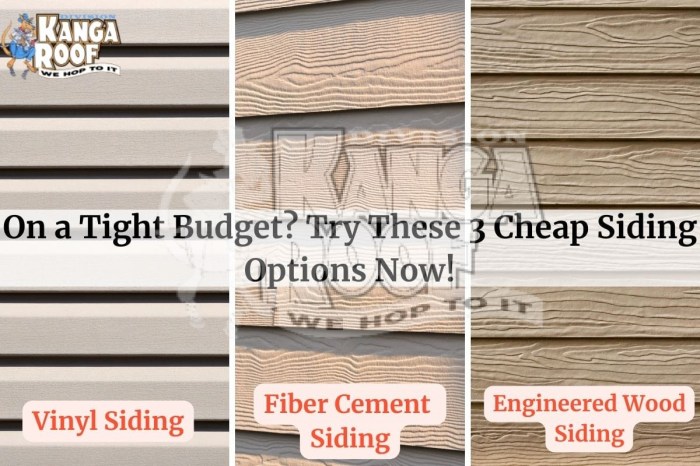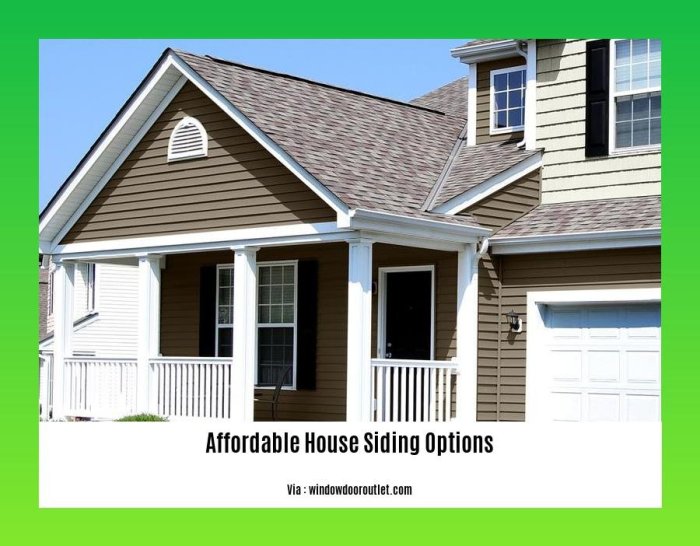Exploring Affordable Home Siding Options: A Comprehensive Guide

Affordable home siding options open up a world of possibilities for homeowners seeking cost-effective yet stylish solutions to revamp their living spaces. In this detailed guide, we delve into the realm of different siding materials, maintenance tips, installation methods, and more, providing a thorough look at how to enhance your home's exterior without breaking the bank.
Whether you're a seasoned DIY enthusiast or prefer the expertise of professionals, understanding the ins and outs of affordable siding options is key to making informed decisions for your property. Let's embark on this informative journey together.
Types of Affordable Home Siding Options
When it comes to choosing affordable home siding options, there are several materials to consider. Each type of siding has its own pros and cons, as well as varying levels of durability and maintenance requirements.
Vinyl Siding
- Pros: Affordable, low maintenance, available in various colors and styles.
- Cons: Can crack in extreme temperatures, may fade over time.
- Durability: Generally long-lasting if properly installed and maintained.
- Maintenance: Requires occasional cleaning with soap and water.
Fiber Cement Siding
- Pros: Durable, resistant to fire, rot, and insects.
- Cons: More expensive than vinyl, heavier and more difficult to install.
- Durability: Very durable and can last for decades with minimal maintenance.
- Maintenance: Requires repainting every 5-10 years, but is otherwise low maintenance.
Wood Siding
- Pros: Natural look, environmentally friendly, can be painted or stained.
- Cons: Prone to rot and insect damage, requires regular maintenance.
- Durability: Can last a long time with proper maintenance, but needs to be regularly inspected and treated.
- Maintenance: Requires regular painting, staining, and sealing to protect against the elements.
Engineered Wood Siding
- Pros: More affordable than natural wood, less prone to rot and insects.
- Cons: Can still be damaged by moisture if not properly maintained.
- Durability: Moderately durable, but may need to be replaced sooner than natural wood.
- Maintenance: Requires regular painting/staining and sealing to prevent water damage.
Aluminum Siding
- Pros: Lightweight, low maintenance, resistant to fire and insects.
- Cons: Can dent easily, limited color options.
- Durability: Very long-lasting and resistant to corrosion, if properly maintained.
- Maintenance: Requires occasional cleaning and repainting if the finish wears off.
Factors to Consider When Choosing Affordable Home Siding

When selecting affordable home siding, several key factors should be taken into consideration to ensure the best choice for your home. Factors such as cost, durability, aesthetics, and maintenance play a crucial role in determining the most suitable siding material for your needs.
Cost
Cost is a significant factor to consider when choosing affordable home siding. It's essential to set a budget and explore options that fit within your financial constraints. Keep in mind that while some siding materials may have a higher upfront cost, they could save you money in the long run due to their durability and low maintenance requirements.
Durability
Durability is another important consideration when selecting home siding. You want a material that can withstand the elements and stand the test of time. Look for siding options that are known for their longevity and resistance to factors like moisture, pests, and UV exposure.
Aesthetics
The visual appeal of your home's siding is also crucial. Choose a material that complements the architectural style of your home and enhances its overall curb appeal. Consider factors like color, texture, and design to ensure that the siding enhances the aesthetic value of your property.
Maintenance
Maintenance requirements vary among different siding materials. Some materials may require regular upkeep, such as painting or sealing, while others are more low-maintenance. Consider how much time and effort you are willing to invest in maintaining your home's siding when making your decision.
Climate and Location
The climate and location of your home can significantly impact the choice of siding material
Consider the specific environmental factors in your region when selecting home siding.
DIY vs. Professional Installation
When it comes to installing home siding, one of the key decisions homeowners face is whether to tackle the project themselves or hire professionals. Each option comes with its own set of costs and benefits, so it's important to weigh them carefully before making a decision.
Costs and Benefits of DIY vs. Professional Installation
- DIY Installation:
- Cost-effective as you can save on labor expenses
- Allows for customization and flexibility in the installation process
- Can be a rewarding experience for those who enjoy hands-on projects
- Professional Installation:
- Guarantees expertise and quality workmanship
- Saves time and effort on the homeowner's part
- May come with warranties or guarantees for the work done
Step-by-step Guide for DIY Siding Installation
- Prepare the surface by cleaning and repairing any existing damage
- Measure and cut the siding panels to fit the dimensions of your home
- Install the starter strip and corner posts for proper alignment
- Begin attaching the siding panels, ensuring they overlap correctly
- Finish off with trim pieces and accessories for a polished look
Risks and Challenges of DIY Siding Projects
- Improper installation can lead to water damage and structural issues
- Lack of experience may result in wastage of materials or incorrect fittings
- Safety hazards such as working at heights or handling power tools
Maintenance and Longevity of Affordable Siding Options
When it comes to affordable siding options, proper maintenance is key to ensuring longevity and preserving the appearance of your home. Each type of siding material has its own maintenance requirements and potential issues that may arise over time. Here, we will discuss how to maintain affordable siding options and extend their lifespan.
Vinyl Siding
Vinyl siding is known for being low-maintenance, but it still requires some care to ensure its longevity. Here are some maintenance tips:
- Regularly clean the siding with a mixture of water and mild soap to remove dirt and grime.
- Inspect for any cracks or damage and repair them promptly to prevent moisture from seeping in.
- Avoid using abrasive cleaners or tools that could damage the surface of the siding.
Tip: Consider applying a protective coating to enhance the durability of your vinyl siding.
Fiber Cement Siding
Fiber cement siding is durable, but it also requires maintenance to prolong its lifespan. Here are some maintenance tips:
- Inspect the siding regularly for signs of moisture damage, such as swelling or warping.
- Repaint the siding every 7-15 years to protect it from the elements and maintain its appearance.
- Clean the siding with a soft brush or cloth to remove dirt and debris.
Tip: Keep plants and trees trimmed away from the siding to prevent moisture buildup and damage.
Wood Siding
Wood siding offers a natural and timeless look, but it requires regular maintenance to prevent decay and weathering. Here are some maintenance tips:
- Inspect the siding for signs of rot, mold, or insect damage and address any issues promptly.
- Regularly clean the siding and apply a fresh coat of paint or stain every 3-7 years to protect it from the elements.
- Seal gaps and cracks in the siding to prevent moisture intrusion.
Tip: Consider treating the wood siding with a water-repellent preservative to enhance its durability.
Closing Notes

As we wrap up this exploration of affordable home siding options, it's evident that with the right knowledge and guidance, upgrading your home's exterior can be a rewarding experience. From weighing the pros and cons of different materials to navigating maintenance requirements, this guide equips you with the tools needed to make confident choices that enhance both the look and longevity of your property.
Here's to creating a more beautiful and resilient home with affordable siding solutions.
FAQ Resource
What are the most common types of affordable home siding options available?
Common types include vinyl, wood, fiber cement, metal, and engineered wood siding, each offering unique benefits and considerations for homeowners.
How can I balance quality and affordability when choosing home siding?
To balance quality and affordability, consider factors like durability, maintenance costs, and aesthetics. Opting for mid-range materials that offer a good mix of longevity and cost-effectiveness is often a prudent choice.
What are the key maintenance requirements to extend the lifespan of affordable siding options?
Regular cleaning, inspections for damage, and prompt repairs are essential to prolonging the lifespan of affordable siding materials. Additionally, applying protective coatings or sealants can help enhance durability.

